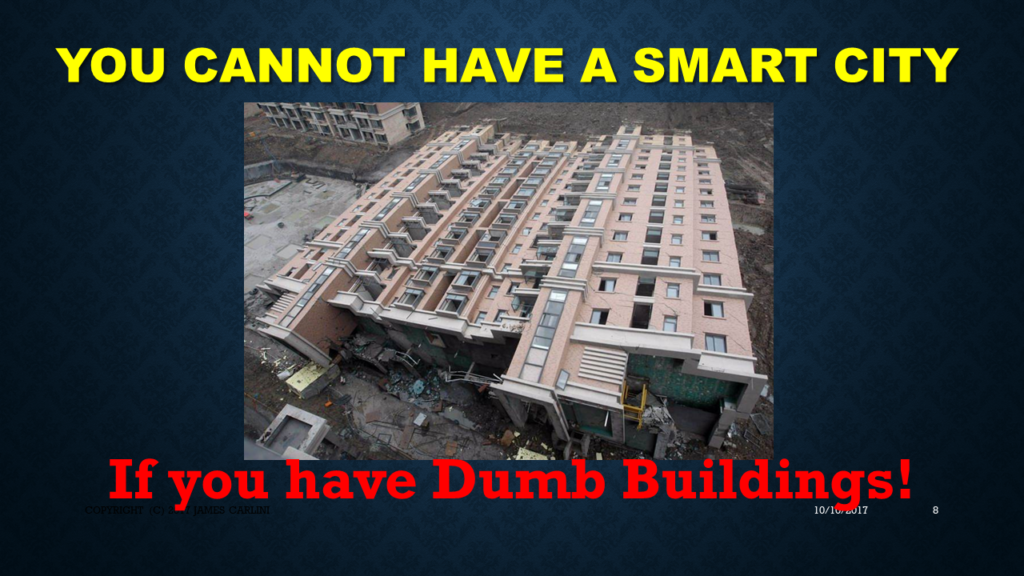INTERVIEW WITH JAMES CARLINI & Ken Sinclair
“Most Office Buildings are Technologically Obsolete and Need Real Updates if They are to Compete in a Shrinking Market.” – James Carlini
James Carlini is a visionary, strategist, and author for Intelligent Buildings, mission-critical networks, technology, and intelligent infrastructure. He has been president of his own consulting and research firm since 1986.
Today as vacancy rates are surging upwards in many cities, there needs to be a re-evaluation of where the commercial leasing market is headed and a pragmatic assessment of where many office buildings are when it comes to being technologically obsolete. This paradigm shift was predicted by James Carlini back in 2020 in a series of articles focused on many companies re-evaluating their workforce and how they manage them.
SINCLAIR: The last time we discussed SMART GRID RESILIENCY: A MUST-HAVE FOR SMART CITIES back in 2021, we were just coming out of the Pandemic. What new issues are you looking at today?
Have the concepts for Smart Cities changed?
CARLINI:
The concepts for Smart Cities need to evolve to reflect the realities of the current office building market. Since 2020, there has been a paradigm shift caused by the Pandemic and the resultant “work-from-home” workforce that has become permanent within many organizations.
SINCLAIR: How has this paradigm shift impacted the commercial real estate industry?
CARLINI:
Since the Pandemic, there has been a paradigm shift in many companies regarding their strategies of keeping their workforce working from home as they shrink their corporate footprint regarding corporate office space leasing. With more of the workforce working at home, this has caused the commercial leasing market to have more to offer than there are takers. In effect, it has caused what I call “the Reverse of Musical Chairs” when leasing up space. You have more and more space opening up for lease, while the demand has shrunk because most companies have decided to reduce the area they require for their employees.
SINCLAIR: Like so many disruptive events in the past, do you think this is a temporary thing? Do you think more organizations will come back to leasing up space?
CARLINI:
No, I believe this will not be a temporary thing and more of a permanent shift. We are NEVER returning to “business as usual,” which some in commercial real estate believe will happen. Many people, for many reasons, want to continue to work from home, and many employers have seen the economic benefits of having those workers work from home. And, those building owners seeking corporate tenants to backfill vacant buildings should have the buildings offering redundant power and other intelligent amenities, like redundant high-speed broadband if they want to attract new corporate tenants.
SINCLAIR: What about commercial buildings that are half-empty? How do we salvage them? Do we try to repurpose them, or do we upgrade them? Or?
CARLINI:
When repurposing buildings, we need to step back and assess our facilities quickly. We need to understand how much it will cost to re-do the floors and other dated entities. We also need to consider whether the structure can support mission-critical applications, which means no single “point-of-failure” in power coming to the building or broadband connectivity.
SINCLAIR: Do you have a way of conveying that to our readers? How redundant do some of the intelligent amenities have to be?
CARLINI:
I talk about the Nine Rs of Intelligent Infrastructure, which should also be found in buildings today. Here is the chart.
THE NINE R’s of INTELLIGENT INFRASTRUCTURE NETWORKS
| THE NINE Rs OF INTELLIGENT INFRASTRUCTURE |
| RELIABILITY |
| REDUNDANCY |
| REDUCED OPERATING COSTS (GREEN) |
| ROBUST DESIGN |
| RESILIENCY (Overall) |
| ROUTING (DIVERSE) |
| RESISTANCE-TO-ATTACKS |
| RIGOROUS REGULAR TESTING |
| REFINEMENT |
Copyright 2021 – James Carlini, all rights reserved
SINCLAIR: That is a concise statement. Why so many requirements?
CARLINI:
With any mission-critical application, you cannot have a single point-of-failure element. Everything needs to be redundant, including power from the utility substation and the broadband connection from the central office.
SINCLAIR: Some real estate experts are telling us there will be a big fire sale on the market, and you can pick up some of these half-empty buildings for a bargain. Isn’t that a good thing?
CARLINI:
There is never a sale on quality. You get what you pay for. Most of these vacant buildings are technologically obsolete and need significant investment to bring them up to speed.
“Junk is still junk – even at a discount.”
All involved need to realize, you cannot have a Smart City, if you have dumb buildings.



